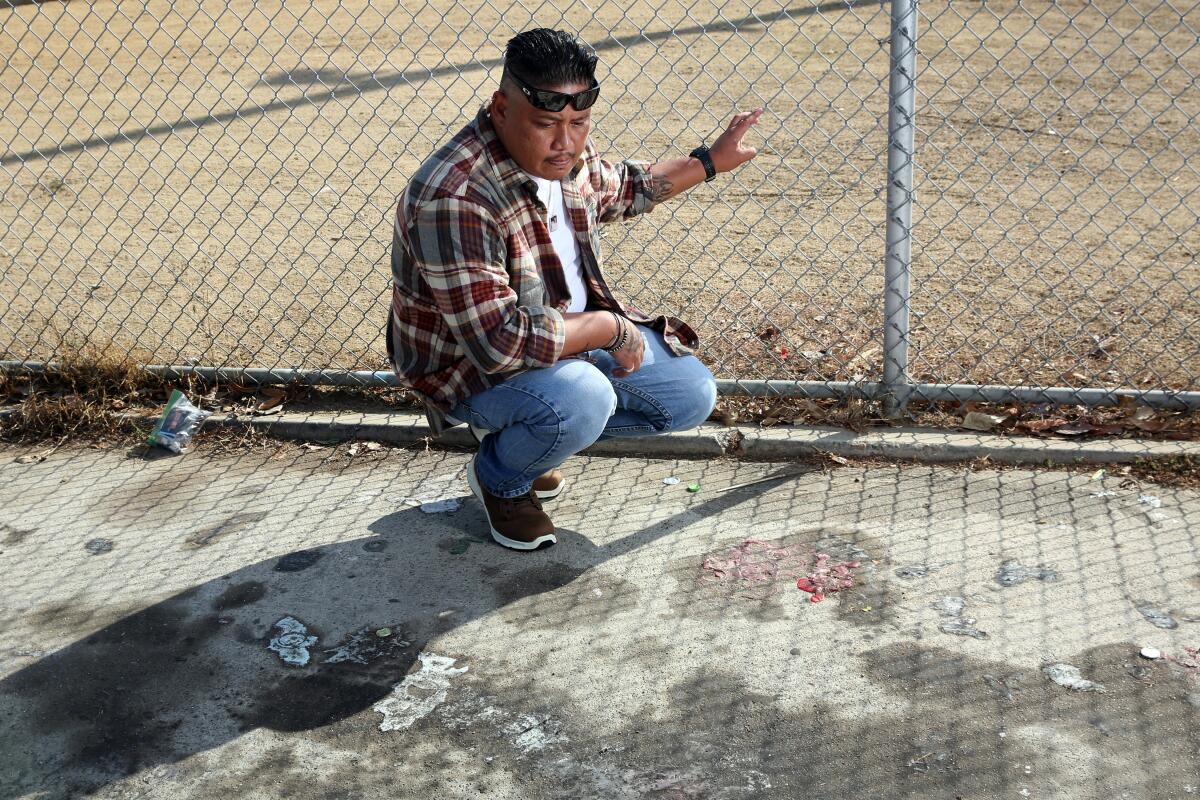Killings in L.A. spike dramatically, leaving families shattered, communities reeling

- Share via
Beneath a highway overpass in South Los Angeles on Saturday night, a detective clicked his flashlight on and off as he carefully placed a yellow evidence marker in the middle of the street and then another closer to the curb, near the pooled blood of a 17-year-old boy.
A big dog barked behind a nearby fence as another detective recounted for his colleague how the teenager had been riding a bicycle when he was gunned down. The boy died en route to a hospital.
His death and three other fatal shootings in L.A. from Saturday into Sunday morning — of a 50-year-old homeless man, a 20-year-old man and a 41-year-old woman — pushed Los Angeles, in an already historic year, to a bloody benchmark not seen in a decade: 300 homicides.
Killings are up 25% over last year and shootings are up more than 32%, mirroring increases in violence that are driving concerns in big cities across the nation. Last week, a pregnant woman was gunned down. Children and elderly residents have been killed. Of all the year’s victims, nearly 20% have been homeless. Gangs are suspected in many cases.
Over the weekend, the violence played out as a weary L.A. fell under a new 10 p.m. limited curfew aimed at halting the spread of another killer: COVID-19. For Police Chief Michel Moore, the fact that there didn’t seem to be anywhere near the amount of concern for the violence was frustrating.
“With the health pandemic, we don’t just cross our arms and say, ‘It is what it is.’ We’re taking all types of efforts to flatten the curve, to lower the impact, to save lives. And that’s what I’m asking for us to do with this violent crime,” he said. “We have a pandemic of crime right now.”
Instead, passion is lacking in the official response, he said. The roughly $3-billion police budget was cut this year by $150 million in the wake of widespread protests against police brutality and misconduct, and Moore said he is scrambling to put more officers on the street — particularly in South L.A., where much of the recent violence has been — as he is slashing specialized units and reducing overtime by half.
“These cuts couldn’t come at a worse time,” Moore said. “My ability to put added resources [in the community] right now is hampered.”
Many activists and police reform advocates continue to contend that it is more robust and better funded social services that will reduce violence, not additional police. They suggest the multibillion-dollar police budget should be reduced further and the funding poured into alternative programs.
For the families of those killed, it is simply the loss that is front of mind.
Shortly before 11:30 a.m. Nov. 15, Arlene Rodriguez — 24 and seven months pregnant with her fourth child — was sitting in the passenger seat of a red sedan in a Wilmington neighborhood while her boyfriend worked on the engine when someone walked up and fired multiple rounds through the back windshield, striking both of them, police said.
It’s unclear who the shooter was trying to target, but LAPD Officer Jeffrey Tiffin, who is investigating the incident, said it is believed to be linked to gang activity in the area. Rodriguez’s boyfriend survived, but she and her unborn child died.
Rodriguez’s stepmother, Jessica Rodriguez, said Arlene Rodriguez had endured multiple tragedies in her life, including her mother dying of liver failure in 2005 and her 17-year-old brother, Richard Rodriguez, being fatally shot in 2011 — just a few blocks from where she was shot this month.
Jessica Rodriguez, who lives in Kansas, said her stepdaughter had struggled with substance abuse but wanted to get her life on track. The 24-year-old recently asked if she could come to Kansas to stay awhile and seek a fresh start.
“She had a lot of dreams in hoping she would be able to get her life back on track and be able to be a better mom for her kids,” Jessica Rodriguez said.
Instead, three months later, the call came that Arlene Rodriguez had been killed.
“They took someone who had so much life ahead of them,” Jessica Rodriguez said of the shooter. “They took three kids’ mom.”
Just before 2 a.m. Sept. 30, cousins Jarrod Santos, 19, and Jesse Meza, 18, were sitting in Santos’ car when someone walked up and opened fire. Detectives believe the two were “misidentified” as gang members.
Roque Santos, Jarrod’s father, said his son had recently become a father himself. His daughter turned 6 months old on the day of her father’s funeral services.
Since the shooting, Roque Santos has found himself visiting the site of his son’s killing daily.
“My mentality was that my son took his last breath here, so I need to be here,” he said.
In past decades, L.A. experienced far more violence, with more than 1,000 homicides in some years in the 1980s and 1990s. But more recently, crime has been on a steady downward trend, both in L.A. and in other major cities. The causes are hard to pin down.
Some credit the expansion of community programs and those aimed at keeping children out of gangs and intervening in street disputes to prevent them from turning into cycles of retaliation. Others suggest gentrification played a role. Still others say policing improved, got smarter and less controversial, and police learned to start working with local communities.
Whatever it was, cities like New York and Los Angeles saw their death rates shrink dramatically.
The last time the city passed 300 homicides was in 2009. In 2010, when Los Angeles ended the year with 293 killings, it was a milestone that marked the lowest number of homicides in the city since 1967, when the population was 30% smaller.
The progress was being felt up until this year, when the coronavirus and its associated economic shutdowns helped upend whatever balance had been paying dividends.
According to Jeff Asher, a crime analyst and consultant based in New Orleans, data suggest that, because of surges in Los Angeles, New York and other big cities, 2020 could see “the largest one-year increase in homicides nationally that we have ever seen” in the U.S., even as “overall murder remains down significantly” from its peak toward the end of the 20th century.
Contrary to statements from some public officials, homicide increases have occurred in cities controlled by both political parties, Asher said. And because the increase is being seen across the board, he thinks “hyper-local explanations” for increases in specific cities — such as a cut to the Los Angeles Police Department budget — are probably incorrect or only part of the answer for why things are going so wrong so fast.
“I would caution people against looking for local explanations for what is clearly a nationally driven trend,” Asher said.
He said there is a major correlation between the “stresses of the pandemic” and the violence, but more study is needed on the connection. There also could be a connection between the violence and “the loss of police legitimacy” before and during massive protests this year, he said.
Fernando Rejón, who works to prevent violence as executive director of the Urban Peace Institute, said the pandemic has exposed gaps in underserved communities that rely on in-person events for connections and support.
In addition, intervention workers — people with ties to the community who work to mediate conflicts — are working to educate people about the coronavirus, and are being spread thin.
In recent years, Moore and his predecessor, Charlie Beck, have credited gang intervention workers with helping to reduce violence in the city. But as the pandemic rages on and people lose jobs and fall into economic despair, intervention workers are trying to play more roles. And some of their work, such as talking to shooting victims at their bedsides to halt cycles of retaliation, has been interrupted by the COVID-19 pandemic.
“They continue to do the city a great service, but they’re not valued,” Rejón said. His organization is calling for more staffing and funding for such work.
At a recent meeting of intervention workers, issues such as homelessness, increased drug use and an increase in assault weapons and “ghost guns” — or guns made on the black market without serial numbers — were also brought up as concerns, he said.
“People are just frustrated and then they don’t have access to their social networks to get together to share information,” Rejón said. “It’s this perfect storm we’re dealing with.”
Moore, who also cited the increased prevalence of ghost guns and the interruptions to gang intervention work as factors in the violence, said he is trying to figure out how to put more officers on the streets of South L.A. to interrupt the violence while also maintaining sufficient personnel to investigate the killings that do occur.
Whether he succeeds in doing so, it can’t just be police trying to stop the violence, he said. Everyone in the city needs to start having a conversation about the current crisis of violence, and figure out what they are going to do to help, he said.
Those who bring extraordinary passion to reforming police would help the city greatly if they put some of that energy toward halting killings, he said.
“We need the community’s help. They have helped and they continue to help us now, but we need their vigilance. If you see something, say something. If you are aware of who is responsible for violence, bring us in. Let us stop this senseless loss of life,” he said. “Los Angeles is better than this.”
More to Read
Sign up for Essential California
The most important California stories and recommendations in your inbox every morning.
You may occasionally receive promotional content from the Los Angeles Times.












